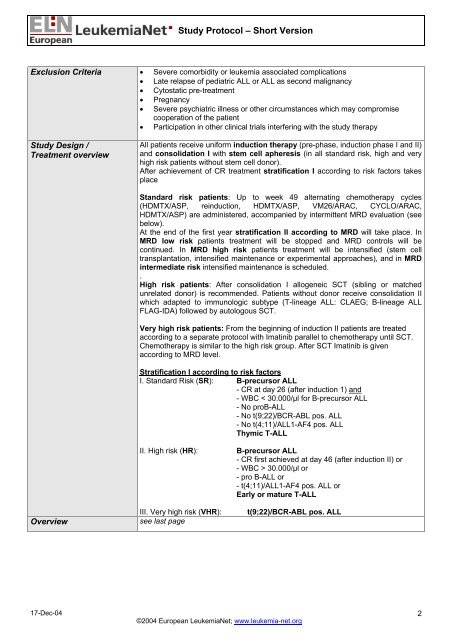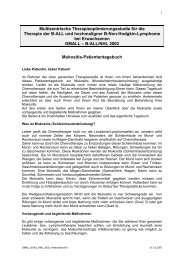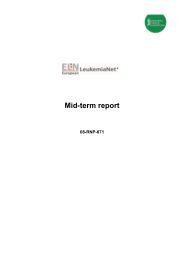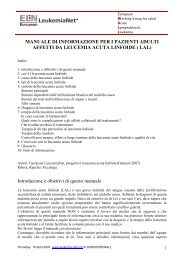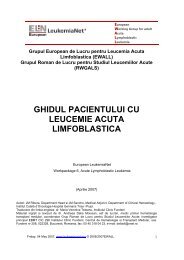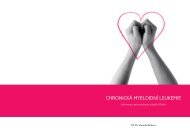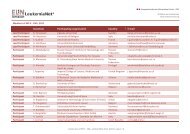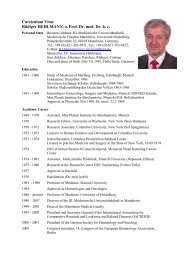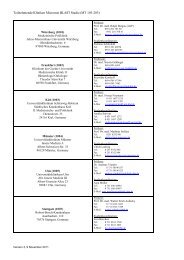Multicenter Study for Adult ALL – GMALL 07/2003 Overview Total ...
Multicenter Study for Adult ALL – GMALL 07/2003 Overview Total ...
Multicenter Study for Adult ALL – GMALL 07/2003 Overview Total ...
Create successful ePaper yourself
Turn your PDF publications into a flip-book with our unique Google optimized e-Paper software.
<strong>Study</strong> Protocol – Short Version<br />
Exclusion Criteria • Severe comorbidity or leukemia associated complications<br />
• Late relapse of pediatric <strong>ALL</strong> or <strong>ALL</strong> as second malignancy<br />
• Cytostatic pre-treatment<br />
• Pregnancy<br />
• Severe psychiatric illness or other circumstances which may compromise<br />
cooperation of the patient<br />
• Participation in other clinical trials interfering with the study therapy<br />
<strong>Study</strong> Design /<br />
Treatment overview<br />
All patients receive uni<strong>for</strong>m induction therapy (pre-phase, induction phase I and II)<br />
and consolidation I with stem cell apheresis (in all standard risk, high and very<br />
high risk patients without stem cell donor).<br />
After achievement of CR treatment stratification I according to risk factors takes<br />
place<br />
Standard risk patients: Up to week 49 alternating chemotherapy cycles<br />
(HDMTX/ASP, reinduction, HDMTX/ASP, VM26/ARAC, CYCLO/ARAC,<br />
HDMTX/ASP) are administered, accompanied by intermittent MRD evaluation (see<br />
below).<br />
At the end of the first year stratification II according to MRD will take place. In<br />
MRD low risk patients treatment will be stopped and MRD controls will be<br />
continued. In MRD high risk patients treatment will be intensified (stem cell<br />
transplantation, intensified maintenance or experimental approaches), and in MRD<br />
intermediate risk intensified maintenance is scheduled.<br />
.<br />
High risk patients: After consolidation I allogeneic SCT (sibling or matched<br />
unrelated donor) is recommended. Patients without donor receive consolidation II<br />
which adapted to immunologic subtype (T-lineage <strong>ALL</strong>: CLAEG; B-lineage <strong>ALL</strong><br />
FLAG-IDA) followed by autologous SCT.<br />
Very high risk patients: From the beginning of induction II patients are treated<br />
according to a separate protocol with Imatinib parallel to chemotherapy until SCT.<br />
Chemotherapy is similar to the high risk group. After SCT Imatinib is given<br />
according to MRD level.<br />
Stratification I according to risk factors<br />
I. Standard Risk (SR): B-precursor <strong>ALL</strong><br />
- CR at day 26 (after induction 1) and<br />
- WBC < 30.000/µl <strong>for</strong> B-precursor <strong>ALL</strong><br />
- No proB-<strong>ALL</strong><br />
- No t(9;22)/BCR-ABL pos. <strong>ALL</strong><br />
- No t(4;11)/<strong>ALL</strong>1-AF4 pos. <strong>ALL</strong><br />
Thymic T-<strong>ALL</strong><br />
II. High risk (HR): B-precursor <strong>ALL</strong><br />
- CR first achieved at day 46 (after induction II) or<br />
- WBC > 30.000/µl or<br />
- pro B-<strong>ALL</strong> or<br />
- t(4;11)/<strong>ALL</strong>1-AF4 pos. <strong>ALL</strong> or<br />
Early or mature T-<strong>ALL</strong><br />
III. Very high risk (VHR): t(9;22)/BCR-ABL pos. <strong>ALL</strong><br />
<strong>Overview</strong> see last page<br />
17-Dec-04<br />
©2004 European LeukemiaNet; www.leukemia-net.org<br />
2


